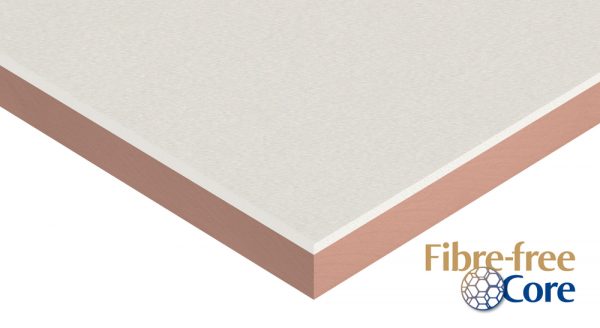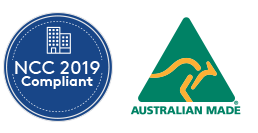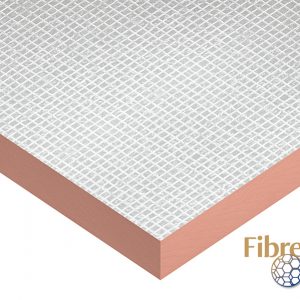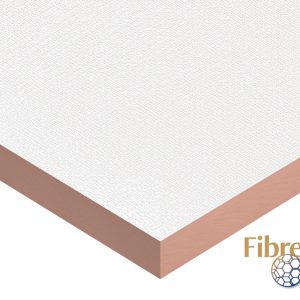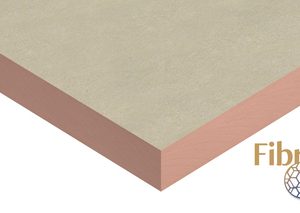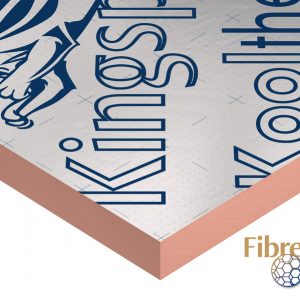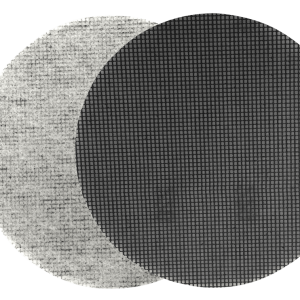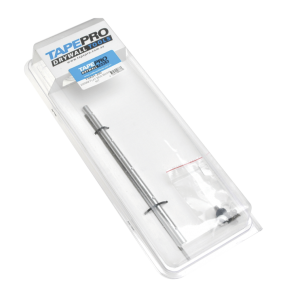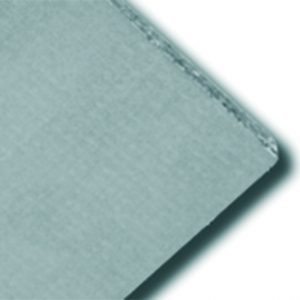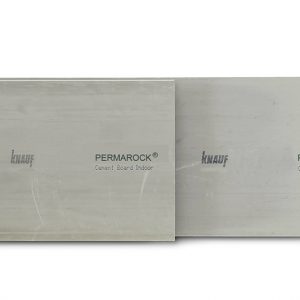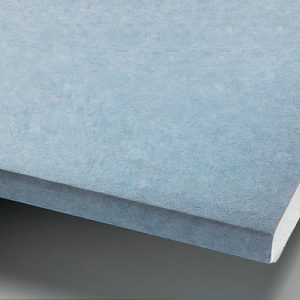| Product Data |
| Declared Thermal Conductivity (λ-Value) |
Insulant |
0.021 W/m.K at 23oC
(Insulant thickness ≥ 45 mm)
0.023 W/m.K at 23oC
(Insulant thickness 25 – 44 mm) |
| Fibre Cement |
0.23 W/m.K at 23oC
(Fibre Cement thickness 6 mm) |
| Product Dimensions |
|
2400 mm x 1200 mm (2.88 m2)
Other dimension available upon enquiry. Minimum order quantities apply. |
| Nominal Product Thickness (including Fibre Cement Sheet) |
|
31, 36, 46, 56, 66 ,76, 86, 96 mm |
| Nominal Fibre Cement Sheet Thickness |
|
6 mm |
A selection of alternative lining boards to create customised finishes and facings is available. Please contact us for more information.

Assumption and Key
NCC 2019 prescribes different methods to determine Total R-value Calculations for Volume 1 and Volume 2.
The R-values shown are Total R-values for the building element as required by the Energy Provisions of the National Construction Code, calculated in accordance with AS/NZS 4859.2 2018 & NZS 4214. Kingspan Kooltherm® products are manufactured, tested and packaged in conformance with AS/NZS 4859.1:2018.
Product R-values
| Nominal Product Thickness (inc. 6mm Fibre Cement Sheet) |
Declared Product R-value |
| 31 mm |
R1.10 |
| 36 mm |
R1.40 |
| 46 mm |
R1.75 |
| 56 mm |
R2.35 |
| 66 mm |
R2.85 |
| 76 mm |
R3.35 |
| 86 mm |
R3.80 |
| 96 mm |
R4.30 |
Concrete Roof (Soffit) – No Suspended Ceiling
System R-value
| Nominal Product Thickness (inc. 6 mm Fibre Cement sheet) |
Heat Flow In (Summer) |
Heat Flow Out (Winter) |
| 31 mm |
RT1.4 |
RT1.4 |
| 36 mm |
RT1.6 |
RT1.6 |
| 46 mm |
RT2.0 |
RT2.1 |
| 56 mm |
RT2.6 |
RT2.7 |
| 66 mm |
RT3.1 |
RT3.2 |
| 76 mm |
RT3.5 |
RT3.7 |
| 86 mm |
RT4.0 |
RT4.2 |
| 96 mm |
RT4.5 |
RT4.7 |
Concrete thickness: 150 mm
Concrete Floor (Soffit) – Unenclosed Sub-Floor
| Nominal Product Thickness (inc. 6 mm Fibre Cement sheet) |
Heat Flow In (Summer) |
Heat Flow Out (Winter) |
| 31 mm |
RT1.4 |
RT1.4 |
| 36 mm |
RT1.5 |
RT1.7 |
| 46 mm |
RT2.0 |
RT2.1 |
| 56 mm |
RT2.6 |
RT2.8 |
| 66 mm |
RT3.0 |
RT3.3 |
| 76 mm |
RT3.5 |
RT3.7 |
| 86 mm |
RT4.0 |
RT4.0 |
| 96 mm |
RT4.4 |
RT4.7 |
Concrete thickness: 150 mm
Concrete Floor (Soffit) – Enclosed Sub-Floor
| Nominal Product Thickness (inc. 6 mm Fibre Cement sheet) |
Heat Flow In (Summer) |
Heat Flow Out (Winter) |
| 31 mm |
RT2.0 |
RT2.1 |
| 36 mm |
RT2.2 |
RT2.4 |
| 46 mm |
RT2.6 |
RT2.8 |
| 56 mm |
RT3.2 |
RT3.5 |
| 66 mm |
RT3.7 |
RT4.0 |
| 76 mm |
RT4.1 |
RT4.4 |
| 86 mm |
RT4.6 |
RT4.9 |
| 96 mm |
RT5.1 |
RT5.4 |
Concrete thickness: 150 mm
Specification Clause
The soffit insulation shall be Kingspan Kooltherm K10 PLUS Soffit Board___ mm thick, with a tested smoke obscuration of not more than 100 m2/kg, comprising a CFC/HCFC-free and zero Ozone Depletion Potential (ODP) rigid thermoset phenolic insulation core with a front facing non-combustible fibre cement sheet and a reverse tissue based facing, manufactured under a management system certified to ISO 9001:2015, ISO 14001:2015, OHSAS 18001:2007 and ISO 50001:2011 by Kingspan Insulation Pty Ltd and shall be installed in accordance with the instructions issued by them. A Project Specific Warranty provided by Kingspan Insulation must be submitted.
Specify with: 

Handling & Storage
Installation should be in accordance with AS 3999:2015, Section 4 – Safety Requirements for Insulation Installation.
Storage
The packaging of Kingspan Kooltherm should not be considered adequate for outdoor protection. Boards should be stored inside a building. If, however, temporary outdoor storage cannot be avoided then the boards should be stacked flat on a level base, clear of the ground, and completely protected from inclement weather through use of a polythene sheet or weatherproof tarpaulin. Boards that have been allowed to get wet should not be used.
Resistance to Solvents
The insulation core is resistant to short-term contact with petrol and with most dilute acids, alkalis and mineral oils. However, it is recommended that any spills be cleaned off fully before the boards are installed. Ensure that safe methods of cleaning are used, as recommended by suppliers of the spilt liquid. The insulation core is not resistant to some solvent-based adhesive systems, particularly those containing methyl ethyl ketone. Adhesives containing such solvents should not be used in association with this product. Damaged boards or boards that have been in contact with harsh solvents or acids should not be used.
OH&S
Kingspan Insulation products are chemically inert and safe to use. A Product Safety Information Sheet is available from Kingspan Insulation Pty Ltd.
Installation must be in accordance with AS 3999 Bulk Thermal Insulation Installation and AS 3000 Electrical Installations (Wiring Rules)
Cutting and Taping
Cutting
Cutting fibre cement sheets should be carried out by using a suitable fibre cement blade. For alternative lining materials ensure an appropriate blade is used. Ensure accurate trimming to achieve close-butting joints and continuity of insulation.
Taping
Taping is not required for bonded boards. In the absence of other protection, exposed board edges should be protected by silver Kingspan Insulation Tape with a minimum 48 mm wide overlap onto the board face or alternatively use a proprietary metal c-section. Where the board edge is exposed at the external building perimeter, appropriate protection should be detailed to shelter from adverse weather.
However, to reduce vapour transmission consideration should be given to sealing the joints.
Concrete Soffit
Kingspan Kooltherm K10 PLUS must be installed in accordance with AS 2908.2:1992 Cellulose Cement Products. Installation should be in accordance with AS 3999:2015 Bulk thermal insulation – Installation.
Fixing Directly to Concrete Soffits
Kingspan Kooltherm® K10 PLUS Soffit Board can be fully restrained to a concrete soffit by the use of minimum 11 No. appropriate mechanical insulation fasteners with a minimum head diameter of
25 mm.
- The fasteners should be evenly distributed over the whole area of the board and designed to provide suitable restraint for the project requirements. Consultation with the chosen fastener supplier is recommended.
- Board joints can be either staggered (see Figure 3) or squared (see Figure 4). 4 No. fasteners along each length – no less than 50 mm – no more than 150 mm from edge of board, 3 No. fasteners along the middle (offset from edge positions as per fasterner fixing diagram below).
- Where the board may be subject to external wind pressure, the requirement for additional fixings should be assessed in accordance with appropriate Australian wind load standards.
- Consideration should be given to the material the fixing is made from and should be deemed appropriate for application, exposure and fire rating by the fixing manufacturer.


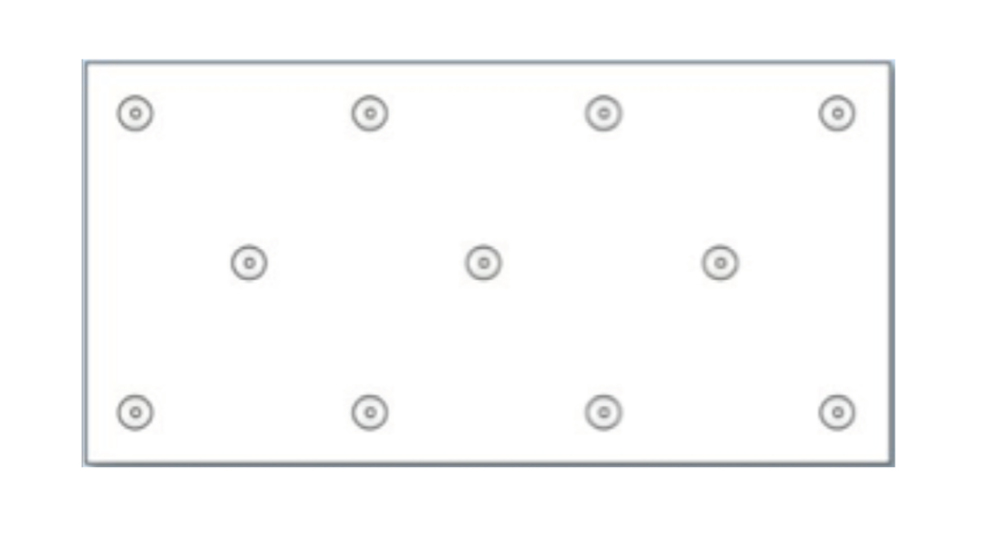
About fixings, why 11 fixings?
Best practice determines that any rigid board insulation, not just Kingspan Kooltherm K10 PLUS Soffit Board, should be fixed with 11 mechanical fixings for very good reasons:
- There will always be differential expansion and contraction between any rigid insulation material and adjacent building products due to varying moisture content and temperature.
- In any concrete forming, there will be an uneven surface throughout the slab.
- Where concrete formwork is joined it is normal to have ridges of up to 3 mm which make the concrete surface uneven.
- An insulation board held horizontally may bow like any other sheetmaterial under its own weight.
Using 11 fixings ensures that the insulation board has a strong and permanent fix under the concrete soffit and that it is not compromised by any of the above issues. It also provides a proven robust fire safe solution.
These best practice recommendations are a result of over 30 years of Kingspan Insulation experience in soffit applications.
Fixing to Timber Battens/Furring Channels
- Alternatively, a treated softwood batten/furring channel lay-out may be adopted if there is an uneven surface or mechanical services present and direct fixing is not possible.
- 50 mm x 25 mm battens/furring channels should be placed at 600 mm centres to coincide with the edges / centres of the boards.
- The battens/furring channels should be fixed to the soffit by the use of a suitable fixing method e.g. shot-fire may be considered.
- Kingspan Kooltherm® K10 PLUS Soffit Board should then be fixed to the treated timber battens/furring channels using suitable screw fixings. These should be placed at maximum 300 mm in rows not greater than 600 mm apart.
- Where the board may be subject to external wind pressure, the requirement for additional fixings may need to be assessed in accordance with appropriate wind load standards.
- Where the board may be subject to external wind pressure, the requirement for additional fixings may need to be assessed in accordance with appropriate wind load standards.
For advice on ancillary materials, such as fixings and tapes please contact our Technical Services Department.
Installation around Fire Collars
- Fitting Kingspan Kooltherm K10 PLUS Soffit Board tight to the fire collar is recommended to reduce the effects of thermal bridging through the slab.
- Do not cover the face of the fire collar. For fire collars to activate in a fire situation the front face needs to be exposed. This is particularly important when using cast-in collars as the face will be flush with the concrete and it would be easy to cover with the insulation board.

Management Standards
| Standard |
Management System |
| ISO 9001:2015 |
Quality Management |
| ISO 14001:2015 |
Environmental Management |
| ISO 45001:2018 |
Health and Safety Management |
| ISO 50001:2011 |
Energy Management |
Product Testing
| Characteristic |
Standard |
Result |
| Compressive Stress (Insulant) |
AS 2498.3 |
Typically exceeds 100 kPa at 10% compression |
| Water Vapour Resistance |
BS EN 12086:1997 / I.S. EN 12086:1998 |
> 35 MN·s/g
For the puspose of calculation of condensation risk, the resistivity of the fibre cement sheet component of the product should be taken as 250 MN·s/g·m. |
Fire Performance
| Test |
Test Method |
Result |
Ignitability
Flame Spread
Heat Release
Smoke Release |
AS 1530.3 |
Spread of Flame Index: 0
Smoke Development ≤ 3* |
NCC Group Number in
accordance with AS 5637.1 |
AS/NZS 3837 /
Amdt 1 |
Group 1** |
Average Specific Extinction
Area |
AS/NZS 3837 |
≤ 100 m2/kg** |
| Fire-resistance test of elements of construction |
AS 1530.4*** |
-/240/240 (HDPE pipe) |
*Applies only to the Kingspan Kooltherm K10 Insulation board used in the manufacture of this composite insulated fibre cement product.
** Applies only to the compliant fibre cement facing.
*** Testing to AS 1530.4 for the Kingspan Kooltherm K10 performed in accordance with NCC BCA C3.15 Opening for service penetrations using a 120 mm concrete soffit.
Environmental Data Table
| Aspect |
Characteristic |
| Recyclability |
Non-contaminated insulation site waste is recyclable, but there are currently no facilities in Australia to process returned material |
| Re-usability |
Re-usable if removed with care (long term of service expected) |
| Water Use |
No water used in Kingspan Insulation’s manufacturing process |
| Blowing Agent Global Warming Potential (GWP) |
Manufactured with a blowing agent that has low GWP |
| Blowing Agent Ozone Depletion Potential (ODP) |
Manufactured with a CFC/HCFC-free blowing agent that has zero ODP |
| Packaging |
Contains 0% recycled product
Polythene wrap and EPS skids 100% recyclable |

